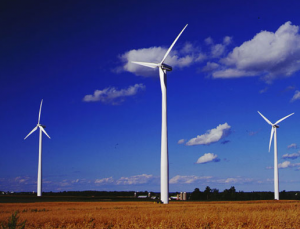Will Big Oil & Other Fossil Fuels Abandon Their Special Tax Breaks?
 The American Wind Energy Association has just released a plan to phase out the Production Tax Credit, an important federal incentive that has led to the doubling of wind generated electricity. This proposal would provide wind companies with six years of certainty before eliminating it.
The American Wind Energy Association has just released a plan to phase out the Production Tax Credit, an important federal incentive that has led to the doubling of wind generated electricity. This proposal would provide wind companies with six years of certainty before eliminating it.This makes the wind industry the only energy resource that has volunteered to help reduce the deficit and our country’s huge debt. Now, it’s time for Big Oil and the rest of fossil fuel industries to propose a plan to phase out their permanent special tax breaks, some of which have been in place for nearly a century.
It’s worth highlighting two points from AWEA’s proposal. First, the PTC must be extended through 2013 during the current Congressional lame duck session, using the language that passed out of the Senate Finance Committee with bipartisan support. Second, the phaseout must include long-term certainty so that a healthy, diverse supply chain remains in place.
The complete letter is available here and is below:
Dear Chairmen Baucus and Camp and Ranking Members Hatch and Levin:
I am writing on behalf of the American Wind Energy Association’s over 2,000 member companies to communicate the industry’s views on the short- and long-term future of the renewable energy production tax credit (PTC).
The PTC is a federal policy that Congress should be proud of. It has unleashed the productive potential of an entrepreneurial industry by providing tax relief that rewards results. The wind industry has reinvigorated American manufacturing, diversified our electricity portfolio, driven down electricity costs for consumers, and stimulated much-needed rural economic development. The wind industry has been ahead of schedule in recent years in meeting the targets of the Bush Administration’s 20% Wind by 2030 plan.
Time and again the industry has made the case to Congress for a PTC renewal, and with overwhelming bipartisan support, the credit has been extended in order to drive more efficient, cheaper and cleaner energy. Still, the stop-start nature of short-term extensions has made it difficult to get the industry to a place where it can be fully cost-competitive. Policy certainty is the only way the industry will be able to make long-term investment decisions that can solidify this American success story.
As you know, the PTC is a performance-based market mechanism that has proven to be the most effective policy to attract private capital and deploy wind technology in the U.S. The wind industry has attracted over $15 billion of private investment annually over the last five years.
Moreover, the credit has led to a 12-fold increase in domestic wind manufacturing, with nearly 500 facilities now producing components for the industry. Businesses located in every state in the country now employ wind workers, and nearly 70% of a turbine’s component parts are manufactured domestically, up from 25% just five years ago. Unfortunately, the PTC is set to expire on December 31, 2012. Most project plans for 2013 have been shelved, triggering layoffs for developers, manufacturers, and the entire supply chain. Navigant Consulting anticipates that without a PTC extension, 37,000 wind industry jobs will be lost by the end of the first quarter of 2013. If the wind industry’s domestic supply chain is lost now, it will take years to build it back up to its current level.
Our top policy priority in the lame duck session is an immediate extension of the PTC, allowing projects that commence construction by the end of 2013 to qualify for the credit. This bipartisan proposal, which was included in the Senate Finance Committee’s tax extenders bill, would immediately restart wind project development and manufacturing, while ensuring that the supply chain infrastructure developed over the last twenty years remains in place.
The wind industry recognizes that our country is facing significant fiscal challenges and is supportive of all energy technology incentives being reviewed and even phased down when Congress considers tax reform. However, the PTC has supported the wind industry in its efforts to significantly reduce the cost of producing electricity, and its continued availability for a reasonable period of time will allow the industry to invest in the cost-saving technologies required to finish the job.
The industry has undertaken an extensive analytical effort to determine what level of the PTC over a specific number of years would be needed to keep the industry minimally viable. The analysis assumed that the industry would meet ambitious technology-improvement and capital- cost targets. Analytical results indicate that a PTC beginning with 2.2 cents per kilowatt-hour, or 100% of the current level for projects that begin construction in 2013, followed by 90%, 80%, 70%, 60%, and then 60% of the current level for projects that are placed in service in years 2014 through 2018, with no PTC in 2019 or afterwards, would sustain a minimally viable industry, able to continue achieving cost reductions.
In coordination with any phase down of the credit, we would urge Congress to consider additional policy mechanisms to encourage a diverse portfolio that includes renewable energy. With the policy certainty that accompanies a stable extension, the industry believes it can achieve the greater economies of scale and technology improvements that it needs to become cost competitive without the PTC.
Congress should be applauded for its support of U.S. wind energy development and manufacturing. To further this economic success story and do so with diminishing federal support, we seek to work with Congress to extend the PTC for a reasonable period of time, as described above.
Sincerely,
Denise A. Bode
CEO
American Wind Energy Association
You can return to the main Market News page, or press the Back button on your browser.

